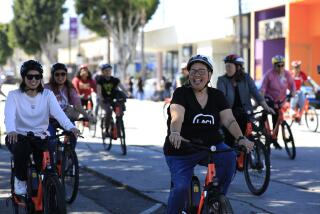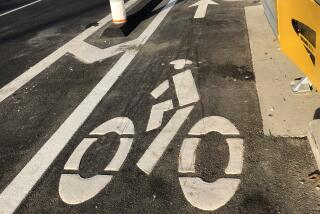A Bicycle Built for a Billion
- Share via
SHANGHAI — At the morning rush hour they form a softly whirring kaleidoscope of pumping legs and spinning wheels, blurs of color as riders wear the bright new clothes of post-Maoist times. Eddies form on the side roads, then merge into vast rivers of movement filling major streets. By the thousands they flow past, silent save for their tinkling bells. The cyclists of China. A transit scene with few parallels on Earth.
Chinese cities live and breathe by the bike. On a first visit in 1979 I was startled to hear city officials bemoaning the onslaught of cycles, asking how it might be “controlled.” I thought, and still do, that it was the wrong question, considering the motorized hells that the automobile has made of so many world cities.
Eight years later, Shanghai’s cycle census has soared 147%, from 1.7 million to 4.2 million cycles. Beijing has doubled its cycle count from 3 million to 6 million. Both cities are adding 500,000 cycles a year. Nor is the phenomenon just urban: Millions of additional bikes now crowd country roads.
Why this bicycle explosion? The prosperity generated by the celebrated economic reforms under Premier Deng Xiaoping has put extra change into peoples’ pockets. The popular Phoenixes, Everlastings and Flying Pigeon brands, costing the equivalent of about 60 U.S. dollars, are one of the first consumer wishes in a nation where per-capita income is only a few hundred dollars a year.
For many Chinese, bus riding is a distant second best. The fares are cheap, but the buses are crammed to the gills. One route here carries 200,000 people a day!
The people, animals and assorted cargoes that the Chinese pile onto bicycles defy the imagination. Wives, babies, grannies, hat racks, huge loads of hay, stacks of furniture swaying precariously from side to side--almost anybody and everything gets balanced on the handlebars or behind the rider. Add a third wheel behind, and the cycle’s potential loads expand to refrigerators, television sets and piles of brick.
Chinese cycle riding can have its down sides. Photographer-journalist Zhou Youma, in China Reconstructs magazine, recites terrors for Beijing cyclists. One is the thin layer of ice that sometimes forms over pavements in winter. Another: “Fellow cyclists spitting in a high wind,” a “disgusting habit” that persists despite many hygiene campaigns against it.
The biggest problem surrounding China’s astronomic numbers of bicycles is how to mix them with the country’s modest but briskly rising numbers of buses, trucks and business and state cars. Last year Shanghai registered 678 traffic-accident fatalities. More than half the victims were cyclists.
The most lethal combination appears to be motorcycle and bicycle. Shanghai already has 10,000 motorcycles, and while officials claim they’re applying stiff controls, they’re permitting 1,000 more a year.
The transportation problems of this city of 12 million, with some neighborhoods of 600 per acre, would faze any traffic engineer, anywhere. The 7 million who live in the inner city are joined by about 2 million commuters a day. Should the city widen the streets, add special lanes for the 5,000 buses? That’s a nice idea, except that buildings would have to be demolished to broaden the roadways. Make pedestrian zones of streets like Nanjing Road, where shoppers crowd in like sardines? A good thought, except that there are no alternative roads to carry vehicular traffic.
How about a subway? Shanghai has a plan for a first 11-mile stretch. But costs are so high that only the first experimental mile has been built.
Government officials meanwhile are trying to introduce more motor vehicles. Trucks are indispensable for a consumer-oriented growth economy. But, when it comes to automobiles, is motorization such a hot idea? If citizens of this densely packed nation of a billion souls suddenly had personal autos, the parking alone would fill every square meter of the cities, plus much of the countryside.
One has to ask: Is China’s dependence on the bicycle really backward? Consider, by contrast, the fumy street chaos of a Bangkok, Cairo or Mexico City. And think to the future, when world petroleum supplies are finally exhausted. We may be scrambling to copy the two-wheeled Chinese model.
More to Read
Sign up for Essential California
The most important California stories and recommendations in your inbox every morning.
You may occasionally receive promotional content from the Los Angeles Times.










